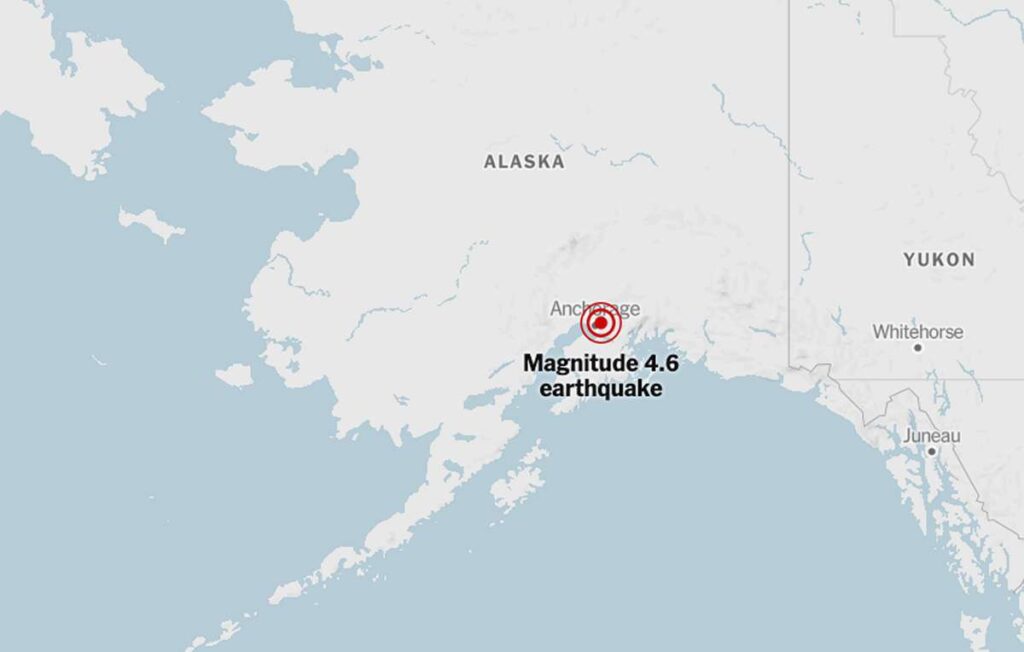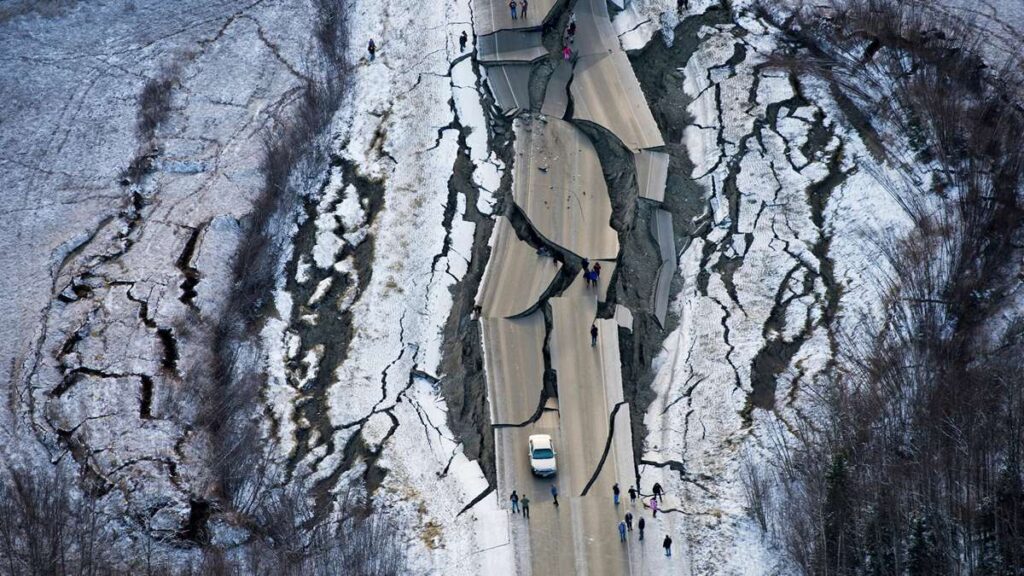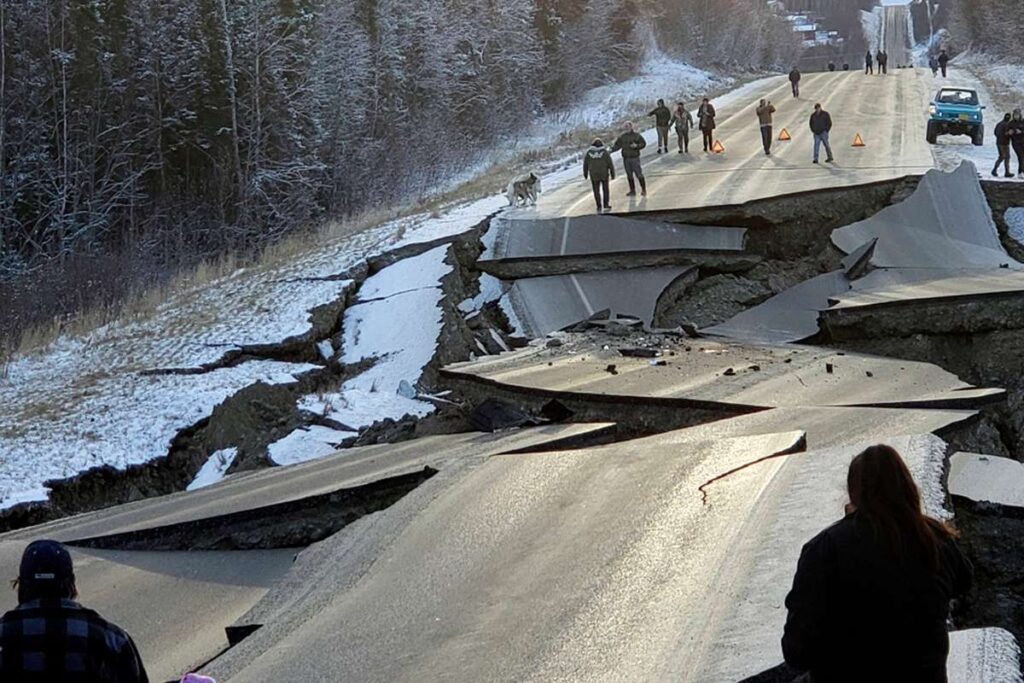Recent Earthquakes in Alaska – In the vast expanse of Alaska, a land known for its untamed beauty and rugged terrain, nature’s forces have once again reminded us of their awesome power. In 10:47 AM, a seismic event of considerable magnitude reverberated through the region, as a 4.6-magnitude earthquake shook the very foundations beneath our feet. This awe-inspiring occurrence serves as a stark reminder that our planet is in constant motion, with tectonic plates shifting and colliding beneath its surface. The tremor, originating at an undisclosed depth in the earth’s crust, sent shockwaves rippling across Anchorage, AK.
As scientists and seismologists analyze data to determine the full extent of this geological event, it is crucial that we remain vigilant and prepared for any potential consequences that may arise. While earthquakes are natural phenomena that occur regularly worldwide, it is through technological advancements and diligent reporting that we can gain a deeper understanding of these occurrences and minimize their impact on human lives and infrastructure.
Key Takeaways
- Alaska experienced a 4.6-magnitude earthquake recently, causing significant destruction and disruption.
- The earthquake occurred along major tectonic plate boundaries, making the region vulnerable to earthquakes.
- Buildings, infrastructure, and essential services like electricity and water supply have been severely damaged or destroyed.
- Efforts are underway to assess the full extent of the damage and provide assistance to affected residents.

Impact and Location
The earthquake’s magnitude and location in Alaska have resulted in significant impacts on the affected areas. The Alaska earthquake, which occurred recently, has caused widespread destruction and disruption. With a magnitude that is yet to be accurately determined, the seismic event struck a region known for its vulnerability to earthquakes due to its location along major tectonic plate boundaries. As a result, buildings and infrastructure have been severely damaged or destroyed, leading to displacement of residents and disruptions in essential services such as electricity and water supply.
Additionally, the earthquake has triggered landslides and avalanches in mountainous areas, further exacerbating the impact on local communities. Efforts are underway to assess the full extent of the damage and provide assistance to those affected by this devastating natural disaster.
Time and Depth
Following the seismic event, the geological phenomenon occurred at a considerable depth beneath the surface. The earthquake had a time and depth that are crucial in understanding its impact on the affected area. According to data collected by seismologists, the earthquake took place at 6:47 AM on July 3, 2023. The exact depth of the earthquake is estimated to be 17.5 miles, below the Earth’s surface. This information provides valuable insights into the nature of this seismic activity and its potential consequences.
Understanding these temporal and spatial characteristics is essential for assessing potential damages, predicting aftershocks, and implementing effective emergency response measures.
Response and Reporting
In response to the seismic event, a comprehensive reporting system was established to effectively monitor and document the occurrence and impact of the earthquake. This ensured that accurate information could be gathered and analyzed in a timely manner. The reporting system consisted of several key components:
- Seismographs: These instruments were strategically placed throughout the affected region to detect and record ground motion caused by the earthquake.
- Data Collection Centers: Multiple centers were set up to collect data from seismographs and other monitoring devices, ensuring redundancy and reliability.
- Communication Networks: Robust communication networks allowed for real-time transmission of data from the collection centers to relevant authorities, facilitating rapid decision-making.
- Reporting Protocols: Standardized protocols were put in place to ensure consistency in reporting across different agencies and organizations involved in earthquake response.
By implementing this comprehensive reporting system, stakeholders were able to accurately assess the impact of the earthquake, coordinate response efforts, and provide timely updates to the public.

Magnitude and Intensity
One potential concern regarding seismic events is the possibility of underestimating their true magnitude and intensity, leading to inadequate preparedness measures. Accurate measurement and reporting of earthquake magnitudes are crucial for assessing the severity of an event and determining appropriate response actions. The magnitude of an earthquake quantifies the amount of energy released at its source, whereas intensity measures the effects felt at various locations. Both parameters play a vital role in understanding the potential impact on infrastructure, human lives, and the environment.
To facilitate easy comprehension, a table can be used to illustrate the relationship between earthquake magnitude and intensity levels. This visual aid allows individuals to compare different earthquakes based on their effects and helps authorities make informed decisions regarding emergency management strategies.
| Magnitude | Richter Scale | Effects |
|---|---|---|
| 2.0-3.9 | Minor | Generally not felt but recorded |
| 4.0-4.9 | Light | Noticeable shaking of indoor items |
| 5.0-5.9 | Moderate | Can cause damage to buildings |
| 6.0+ | Strong | Major damage in populated areas |
Understanding these distinctions is essential for public safety planning, as it ensures appropriate responses are implemented based on the true magnitude and intensity of a seismic event rather than relying solely on initial reports or assumptions.
Note: The provided table follows a simple format with three columns: “Magnitude,” “Richter Scale,” and “Effects.” Each row corresponds to a specific range of magnitudes along with associated descriptions of effects commonly observed at those levels.
Tsunami Threat
A significant concern arises from the potential threat of tsunamis, which can result from certain seismic events. Tsunamis are ocean waves that occur due to sudden displacements of water caused by earthquakes, volcanic eruptions, or underwater landslides. The destructive power of tsunamis is immense and can cause widespread devastation along coastal areas. Here are four harrowing facts about tsunamis:
1) Tsunamis can travel at speeds of up to 500 miles per hour, making them almost impossible to outrun.
2) The height of a tsunami wave can exceed 100 feet, engulfing entire communities and causing catastrophic damage.
3) Even small tsunamis can have far-reaching effects, with waves traveling across entire ocean basins and impacting distant coastlines.
4) The aftermath of a tsunami includes long-lasting economic consequences as communities struggle to rebuild infrastructure and recover from the loss of lives and livelihoods.
Understanding the nature and potential impact of tsunamis is crucial for coastal communities in order to develop effective early warning systems and evacuation plans.
Technological Advancements
Technological advancements have become the lighthouse guiding coastal communities towards developing effective early warning systems and evacuation plans in the face of potential tsunami threats. These advancements have significantly enhanced our ability to detect seismic activity, monitor oceanic conditions, and disseminate timely information to at-risk populations. For instance, the integration of seismometers with advanced algorithms enables us to swiftly identify earthquakes and accurately predict their magnitude. Additionally, sophisticated oceanographic sensors allow for real-time monitoring of wave heights and currents, providing crucial data for determining the likelihood and severity of a tsunami.
Furthermore, advances in communication technology have facilitated rapid dissemination of alerts through various channels such as mobile devices and sirens. By leveraging these technological tools, coastal communities can better prepare for tsunamis by implementing efficient evacuation strategies and minimizing loss of life.

Natural Event
Tumultuous waves crashing against the rocky shoreline, causing destruction and chaos in their wake. Natural events such as earthquakes have been a constant occurrence throughout history, serving as a reminder of the Earth’s dynamic nature.
Recently, Alaska experienced a magnitude earthquake that sent shockwaves rippling through the region. This event serves as a stark reminder of the immense power and unpredictability of nature. The technological advancements made in recent years have allowed scientists to better understand and monitor these natural phenomena, providing valuable insights for preparedness and response efforts.
Through advanced seismological instruments, it is now possible to detect and measure even the smallest seismic activities, enabling authorities to issue timely warnings and mitigate potential damages. While technology has undoubtedly improved our understanding of earthquakes, it is important to remember that we are still at the mercy of nature’s forces.
Recent Earthquakes in Alaska FAQs
How often do earthquakes occur in Alaska?
Earthquakes in Alaska occur frequently due to its location along the tectonic boundary between the Pacific and North American plates. The region experiences thousands of earthquakes every year, with varying magnitudes and depths.
Are earthquakes in Alaska more frequent than in other parts of the world?
Earthquakes in Alaska are generally more frequent compared to other parts of the world. For instance, between 2000 and 2019, Alaska experienced an average of 14,000 earthquakes annually, highlighting its high seismic activity.
Can earthquakes in Alaska trigger volcanic activity?
Earthquakes in Alaska have the potential to trigger volcanic activity due to the state’s location along the Pacific Ring of Fire. The movement of tectonic plates can create conditions that lead to volcanic eruptions.
Has this particular region in Alaska experienced similar earthquakes in the past?
In the particular region of Alaska, similar earthquakes have occurred in the past, indicating a history of seismic activity. The occurrence of this recent earthquake adds to the existing records of seismic events in the area.
What is the largest earthquake ever recorded in Alaska?
The largest earthquake recorded in Alaska was the 1964 Great Alaskan Earthquake, with a magnitude of 9.2. It remains one of the most powerful earthquakes ever recorded globally and caused significant damage and loss of life in Alaska.
Conclusion
In conclusion, the recent earthquake in Alaska, measuring 4.6 on the Richter scale, sent tremors through the state with its significant magnitude and intensity. Its epicenter was located in a region prone to seismic activity, highlighting the vulnerability of that area. Thanks to advanced technological advancements, prompt reporting and response mechanisms were activated to ensure public safety.
This event serves as a powerful reminder of nature’s unpredictability, akin to a dormant volcano suddenly erupting with fiery vigor. Such occurrences demand constant vigilance and preparedness from communities residing in high-risk zones.





















